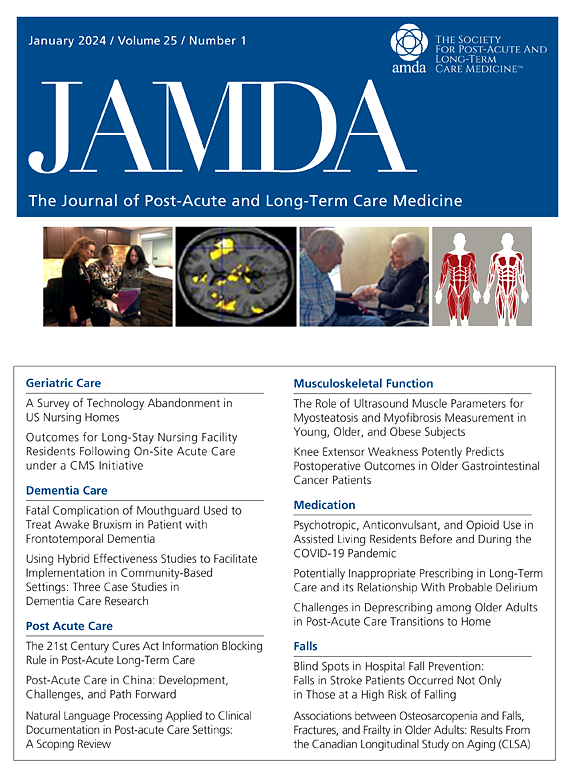高医疗补助支付者组合损害了养老院人员支出和水平。
IF 3.8
2区 医学
Q2 GERIATRICS & GERONTOLOGY
Journal of the American Medical Directors Association
Pub Date : 2025-06-30
DOI:10.1016/j.jamda.2025.105723
引用次数: 0
摘要
目的:医疗补助是大多数养老院居民的主要付款人,报销低于护理成本,限制了养老院增加人员配备水平的能力。本研究考察了护理人员水平和支出与医疗补助支付者组合的关系,并确定这些关系是否在不同的所有权类型中有所不同。设计:采用独立养老院的2023年医疗保险成本报告和基于工资的期刊(PBJ)数据进行回顾性横断面分析。环境和参与者:分析了全国11,559家养老院的代表性样本。方法:根据医疗补助支付者组合将养老院分为5组(0% ~ 50%、51% ~ 65%、66% ~ 75%、76% ~ 85%和86%+)。我们测量了护理人员的水平和每个住院日的支出,以及在护理人员身上花费的收入比例。线性回归模型用于评估医疗补助支付者组合与这些结果之间的关系,允许影响因所有权类型而异。结果:护理人员水平随着医疗补助支付者组合的增加而下降,护理人员总工时从最低医疗补助组的4.08小时下降到最高医疗补助组的3.40小时。医疗补助支付者比例较高的机构,其收入和护理人员的人均住院日支出也较低,但其收入中用于人员配备的比例较大。例如,有86%以上医疗补助支付者的机构将其收入的41.5%用于人员配备,而在医疗补助天数不到50%的机构中,这一比例为36.9%。所有权类型缓和了这些关联,非营利组织比营利性组织对医疗补助支付者组合的变化更敏感。结论和启示:医疗补助支付者比例高的养老院面临着财务约束,尽管分配了更大份额的收入给人员,但这限制了人员配备水平。当政策制定者考虑人员配置要求时,他们必须解决医疗补助报销的充分性问题,以支持人员配置并保持医疗质量。本文章由计算机程序翻译,如有差异,请以英文原文为准。
Nursing Home Staffing Expenditures and Levels are Impaired by High Medicaid Payer-Mix
Objectives
Medicaid is the primary payer for most nursing home residents and reimburses below the cost of care, limiting the ability of nursing homes to increase staffing levels. This study examined the association of nursing staff levels and expenditures with Medicaid payer-mix and determined whether these associations varied across different ownership types.
Design
Retrospective, cross-sectional analysis using 2023 Medicare Cost Reports and Payroll-Based Journal (PBJ) data for freestanding nursing homes.
Setting and Participants
A nationally representative sample of 11,559 nursing homes was analyzed.
Methods
Nursing homes were categorized into 5 groups based on Medicaid payer-mix (0%–50%, 51%–65%, 66%–75%, 76%–85%, and 86%+). We measured nursing staff levels and expenditures per resident day, and the proportion of revenue spent on nursing staff. Linear regression models were used to assess associations between Medicaid payer-mix and these outcomes, allowing effects to vary by ownership type.
Results
Nursing staff levels decrease as Medicaid payer-mix increases, with total nursing staff hours per resident day declining from 4.08 in the lowest Medicaid group to 3.40 in the highest. Facilities with a higher Medicaid payer-mix also have lower revenues and nursing staff expenditures per resident day but allocate a greater proportion of their revenue to staffing. For example, facilities with 86%+ Medicaid payer-mix spend 41.5% of their revenue on staffing, compared with 36.9% in facilities with less than 50% Medicaid days. Ownership type moderates these associations, with not-for-profits more sensitive to Medicaid payer-mix changes than for-profits.
Conclusions and Implications
Nursing homes with a high Medicaid payer-mix face financial constraints that limit staffing levels despite allocating a larger share of revenue to staffing. As policymakers consider staffing mandates, they must address the adequacy of Medicaid reimbursement to support staffing and maintain quality of care.
求助全文
通过发布文献求助,成功后即可免费获取论文全文。
去求助
来源期刊
CiteScore
11.10
自引率
6.60%
发文量
472
审稿时长
44 days
期刊介绍:
JAMDA, the official journal of AMDA - The Society for Post-Acute and Long-Term Care Medicine, is a leading peer-reviewed publication that offers practical information and research geared towards healthcare professionals in the post-acute and long-term care fields. It is also a valuable resource for policy-makers, organizational leaders, educators, and advocates.
The journal provides essential information for various healthcare professionals such as medical directors, attending physicians, nurses, consultant pharmacists, geriatric psychiatrists, nurse practitioners, physician assistants, physical and occupational therapists, social workers, and others involved in providing, overseeing, and promoting quality

 求助内容:
求助内容: 应助结果提醒方式:
应助结果提醒方式:


